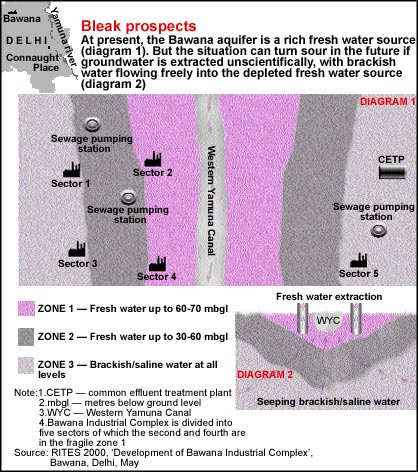Relocation pangs
 Bawana's bucolic settings have all but made way for Asia's largest industrial hub. The sea change that this northwest Delhi locality is undergoing may, however, leave the area's aquifer depleted and polluted. This is likely to have a ripple effect because Bawana is projected as a future groundwater source for the entire parched capital. Also, since Delhi slopes naturally from north to south, pollution in Bawana's aquifer will percolate down to those in the rest of the city.
Bawana's bucolic settings have all but made way for Asia's largest industrial hub. The sea change that this northwest Delhi locality is undergoing may, however, leave the area's aquifer depleted and polluted. This is likely to have a ripple effect because Bawana is projected as a future groundwater source for the entire parched capital. Also, since Delhi slopes naturally from north to south, pollution in Bawana's aquifer will percolate down to those in the rest of the city.
The Bawana Industrial Complex (bic) will soon be the new address for 16,000 units being shifted from Delhi's non-conforming zones on the Supreme Court's (sc) orders. Even as officials of the Delhi government wax eloquent about the project, experts point out that bic is beset with environmental problems. Right from site selection to relocation of industries. "The issue has been thrust down our throats by politicians,' says a Delhi-based planner.
Handle with care "It is a low-lying area and recharge zone. Unlike most other parts of the capital, Bawana is a rich groundwater source,' reveals K T Ravindran, head of the department of urban design, School of Planning and Architecture (spa). According to the Central Ground Water Authority (cgwa), Bawana's water table is shallow. This means that water can be struck between 1.5 metres below ground level (mbgl) and 4.5 mbgl. By contrast, the groundwater level in south Delhi is as low as 30 mbgl. Certain spots in Bawana that are in the vicinity of the western Yamuna canal have fresh water up to a depth of 60-70 mbgl
